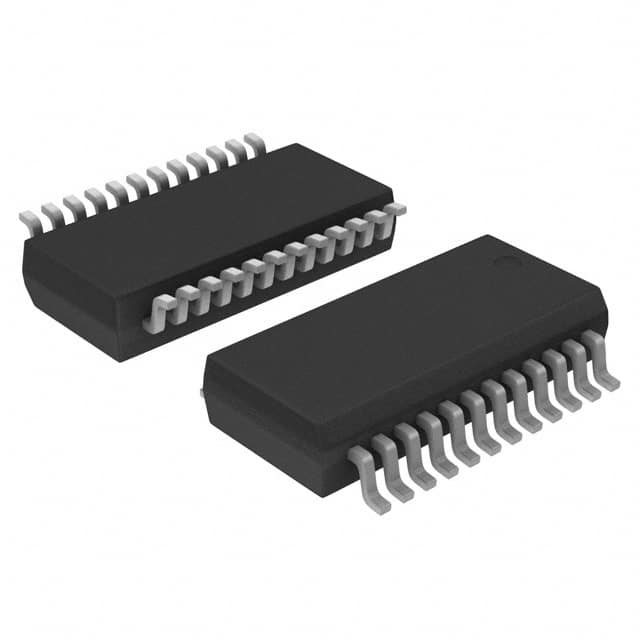Consulte las especificaciones para obtener detalles del producto.

MAX528EAG+T
Product Overview
- Category: Integrated Circuit (IC)
- Use: Digital-to-Analog Converter (DAC)
- Characteristics: High precision, low power consumption
- Package: 24-pin SSOP (Shrink Small Outline Package)
- Essence: Converts digital signals into analog voltage or current
- Packaging/Quantity: Tape and reel, 2500 units per reel
Specifications
- Resolution: 12 bits
- Number of Channels: 1
- Supply Voltage: 2.7V to 5.5V
- Operating Temperature Range: -40°C to +85°C
- Output Type: Voltage or Current
- Output Range: 0V to Vref (Voltage mode), 4mA to 20mA (Current mode)
- DNL (Differential Non-Linearity): ±1 LSB (Maximum)
- INL (Integral Non-Linearity): ±2 LSB (Maximum)
Pin Configuration
The MAX528EAG+T has a total of 24 pins. The pin configuration is as follows:
- VDD: Positive supply voltage
- AGND: Analog ground
- REFOUT: Reference output voltage
- VREF: Reference input voltage
- CS: Chip select input
- SCLK: Serial clock input
- DIN: Serial data input
- DGND: Digital ground
- OUT: Analog output voltage or current
- LDAC: Load DAC input
- CLR: Clear input
- GAIN: Gain selection input
- A0-A11: Address inputs
- NC: No connection
- NC: No connection
- NC: No connection
- NC: No connection
- NC: No connection
- NC: No connection
- NC: No connection
- NC: No connection
- NC: No connection
- NC: No connection
- NC: No connection
Functional Features
- High precision digital-to-analog conversion
- Low power consumption for energy-efficient applications
- Serial interface for easy integration with microcontrollers or other digital systems
- On-chip reference voltage generator for accurate conversion
- Selectable gain for flexible output range
- Load DAC input for simultaneous update of multiple DACs
- Clear input for resetting the DAC output to zero
Advantages and Disadvantages
Advantages: - High precision conversion ensures accurate analog output - Low power consumption extends battery life in portable devices - Serial interface simplifies integration with digital systems - Flexible output range allows for various applications
Disadvantages: - Limited to a single channel output - Requires an external reference voltage source - May require additional components for specific applications
Working Principles
The MAX528EAG+T is a digital-to-analog converter (DAC) that converts digital signals into analog voltage or current. It utilizes a 12-bit resolution to provide high precision conversion. The device operates with a supply voltage ranging from 2.7V to 5.5V and can handle temperatures from -40°C to +85°C.
The DAC accepts serial data input through the DIN pin and uses the SCLK pin for clock synchronization. The CS pin is used to select the device for communication. The converted analog output is available at the OUT pin, which can be configured as either voltage or current mode.
The MAX528EAG+T features a built-in reference voltage generator (VREF) for accurate conversion. It also offers a selectable gain option (GAIN) to adjust the output range according to the application requirements. The LDAC pin allows for simultaneous updating of multiple DACs, while the CLR pin resets the output to zero.
Detailed Application Field Plans
The MAX528EAG+T is suitable for various applications that require precise analog voltage or current outputs. Some potential application fields include:
- Industrial Automation: Control systems, process monitoring, and instrumentation.
- Audio Equipment: Digital audio processing, volume control, and equalization.
- Test and Measurement: Calibration equipment, data acquisition systems, and signal generation.
- Communication Systems: Base stations, transceivers, and signal conditioning.
- Automotive Electronics: Engine control units, climate control, and infotainment systems.
Detailed and Complete Alternative Models
- MAX531BCPD+: 12-bit DAC with dual channels and parallel interface.
- MAX517BCPA+: 14-bit DAC with single channel and serial interface.
- MAX5353BCUA+: 16-bit DAC with single channel and I2C interface.
- MAX521AEAG+: 10-bit DAC with single channel and SPI interface.
- MAX541CCSA+: 14-bit DAC with dual channels and voltage output.
These alternative models offer different resolutions, channel configurations, and communication interfaces to suit specific application requirements.
Enumere 10 preguntas y respuestas comunes relacionadas con la aplicación de MAX528EAG+T en soluciones técnicas
Sure! Here are 10 common questions and answers related to the application of MAX528EAG+T in technical solutions:
Q: What is the MAX528EAG+T? A: The MAX528EAG+T is a precision, low-power, 8-bit digital-to-analog converter (DAC) that can be used in various technical applications.
Q: What is the resolution of the MAX528EAG+T? A: The MAX528EAG+T has an 8-bit resolution, which means it can provide 256 different output voltage levels.
Q: What is the supply voltage range for the MAX528EAG+T? A: The MAX528EAG+T operates with a supply voltage range of 2.7V to 5.5V.
Q: Can the MAX528EAG+T be used in battery-powered applications? A: Yes, the low-power characteristics of the MAX528EAG+T make it suitable for battery-powered applications.
Q: What is the typical settling time of the MAX528EAG+T? A: The typical settling time of the MAX528EAG+T is 6µs, ensuring fast and accurate voltage outputs.
Q: Does the MAX528EAG+T have any built-in reference voltage? A: No, the MAX528EAG+T requires an external reference voltage for its operation.
Q: Can the MAX528EAG+T be controlled using a microcontroller? A: Yes, the MAX528EAG+T can be easily interfaced with a microcontroller using standard digital communication protocols like SPI or I2C.
Q: What is the temperature range in which the MAX528EAG+T can operate? A: The MAX528EAG+T has an extended temperature range of -40°C to +85°C, making it suitable for a wide range of environments.
Q: Can the MAX528EAG+T be used in industrial automation applications? A: Yes, the MAX528EAG+T is designed to meet the requirements of industrial automation applications and can provide precise analog control signals.
Q: Are there any evaluation boards or development kits available for the MAX528EAG+T? A: Yes, Maxim Integrated provides evaluation kits and reference designs that can help developers quickly prototype and evaluate the MAX528EAG+T in their technical solutions.
Please note that these answers are general and may vary depending on specific application requirements. It is always recommended to refer to the datasheet and application notes provided by the manufacturer for detailed information.

